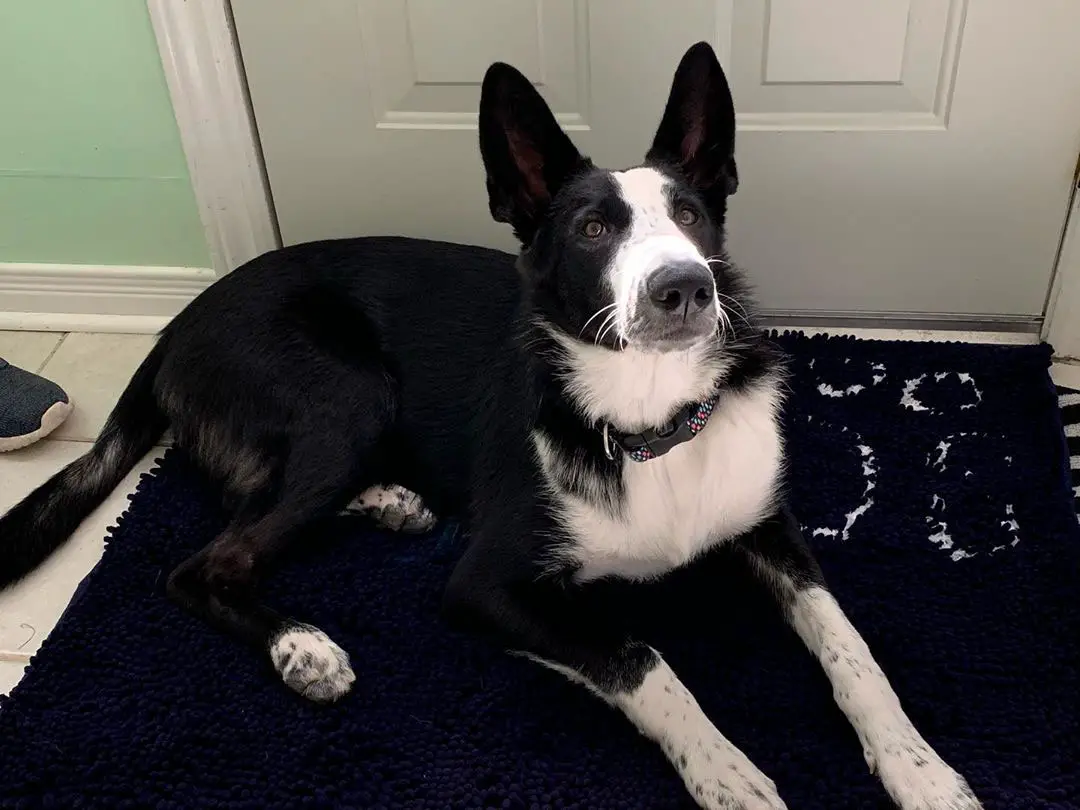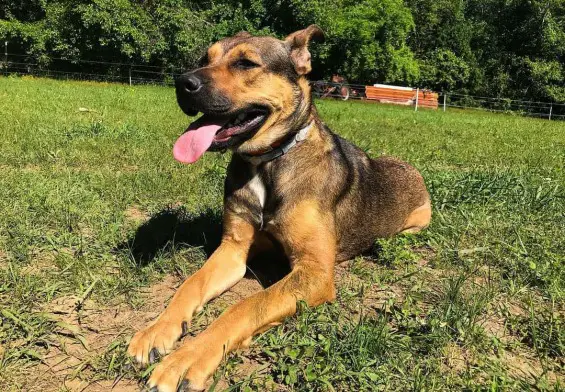Panda Bear GSD Dog Breed Puppy & Dog Guide
If you think you are the only one who has seen the Panda German shepherd and want to share your experience with others. Well yes, they are very uncommon and you are not alone in the world to have seen one.
Many individuals who have worked with the dogs had the advantage of witnessing the Panda German Shepherd. You might have also seen one with its human taking a stroll in a garden while jogging. The German shepherd looks like a tricolor which is beautiful. Some people even think that it is not a purebred but when they research about the GSD, they find that it is one of the most uncommon breeds which can be seen also known as Panda German Shepherd.
Many people want to know about the Panda German Shepherd. Panda German Shepherd has a color variation which is found in many dogs such as back and white. This color combination is also found in the cute looking wild animal also known by the same name Panda. The Panda German Shepherds are very unique and have been typically found as black with 35% tan which looks more or less of the color white. However, a Panda German Shepherd can have a pattern on a coat which is more or less like a Panda which is not that white. Other than the coat color Panda Shepherds are the same as the GSD’s. They have the same intelligence, temperament & qualities.
Where Did Panda Shepherds Originate?
Panda Shepherd like all other German Shepherds trace their lineage to Beowulf. Similar to his grandsire, Horand von Grafrath, had fathered almost 100 pups, most of them through inbreeding. Horand was the 1st sire of the German Shepherd breed, Max Von Stephanitz had hand selected the first sire in the year 1899 in Germany.
Another person Cindy Whitaker had by mistake bred the first recorded Panda German Shepherd in the year 200 in the USA. The father of the breed was Brain von Wolper Lowen SCHH III, the color of the dog was black and tan who was registered in the German Shepherd club. Cynthia Madchen Alspach was a black German Shepherd and also the mother of the pup and was also part of the AKC registry. Out of the three siblings born of the parents. Only one who was named Lewcinka’s Franks von Phenom or just Franka had the Panda pattern.
Later American kennel Club proved through the DNA tests that the Panda GSD puppy Lewcinka’s Franks von Phenom was a Panda German Shepherd and was also registered as a pure breed as she passed the OFA scoring. There was a research on the shepherd which revealed that the panda pattern was different from others and was a mutation which spontaneously happened to the shepherd.
How Do Panda German Shepherds Differ From The Piebald Dogs Of Other Breeds?
Our understanding about the genes of the dogs which are responsible for the color of the dog coat is still evolving. It has to be evolved more when it comes to the appearance in white. The pattern of coat depends on the result of genetics and receives coding from the breed. Piebald gene is an expression when the shepherd has a white marking or spotting. The piebald gene is carried by S locus or location.
The S alleles can be recessive or dominant. If it is recessive then the dogs must have both copies of the genes of piebald. However, if there is one marking then it may show some white marking but two copies might show a huge area which covers most of the dog’s body.
One such example where you can see the piebald gee and the variation because of its existence is in the Bulldog. Several breeds like Irish Setter, Great Dane and Boston Terrier show symmetrical white type marking while on the Dachshund the markings are more prominent.
While the Irish White pattern is seen in the Collies and many other breeds which are mentioned above. An Irish white pattern is seen amongst most of the coat which makes the color to vary and thus a recessive gene is found on the S locus that can be distinct and appears differently than the piebald gene.
Panda Gene in the GSD Is a Mutation in the Kit
It was in the year 2016 that the UC Davis found the mutation on the KIT gene which was mainly responsible for the panda pattern in the German Shepherds. Although originally it sprung up spontaneously from the standard parents, the GSD panda coat pattern is a pretty dominant gene. Any dog that possesses this gene for panda coloration will display the symmetrical white pattern. It will also pass the gene to almost 50% of his or her own puppies.
It is good for you to know that pandas are a kind of piebald pattern. The color white will show up minimally on the tip of the tail, a white ring around the muzzle, as a white blaze down the front of the face, as a collar around the dog’s neck, and as a splash across the belly and chest. Although the pattern remains more or less similar between dogs, individual dogs may exhibit somewhat white.
There is another unique feature of the panda gene. Two copies of the gene are quite lethal, killing the embryo even before it gets a chance to fully develop. It somewhat shares embryonic lethality that is common with the merle gene. There are several panda shepherds that have a base color of tan and black. However, the pattern may even show up in solid black, blue, or liver dogs. It may also include liver and tans, blue and tans, and silver and tans.
What Is The Function Of The Kit?
The KIT gene is also known by many other names. These include Piebald Trait Protein and Receptor Tyrosine Kinase. This gene contains a blueprint for producing different proteins that transmit important information from the cell surface to the different internal working parts. This is why KIT enables processes that may include migration of cells and cellular growth to their more specific areas of function.
KIT genes, for example, make sure that cells, which are responsible for the functioning of the nerves in the gut area, arrive in the small intestine. Similarly, the direct pigmentation cells of the KIT genes are called melanocytes. These migrate throughout different areas of the coat. Most commonly seen in the Panda German Shepherd. You will find spotting where the melanocytes fail to reach. One of the body parts of the dog where you may not consider the melanocytes to be too crucial are the eyes. Panda Shepherds may sometimes have blue eyes. This is possible if the KIT mutation affects the migration process of the melanocytes to the iris.
Panda GSD Is Indeed a German Shepherd
The Panda Shepherd has encountered numerous resistances mainly for its existence. When her DNA was tested, Franka’s owners had their fair share of doubts. Although the American Kennel Club received an early proof of the Panda GSD’s purebred heritage, they decided to classify the pattern as well outside of the breed standard.
There are many German Shepherd registries together with the AKC that disqualify dogs that have even the slightest white coloration from conformational show rings. Nonetheless, they do not reject dogs from their registries based on color. Germany avoids registering white German Shepherds. There are some breeders who maintain long-held beliefs that Panda Shepherds have been passing along the white gene. Even worse, they cause fading in dogs who have standard colors. There have been several genetic laboratories that have confirmed the fact that Panda Shepherds do not possess any white gene. However, they are unsure about the effect on color intensity.
There are several similarities between the Panda Shepherd and the German Shepherd. Some of the most common similarities have been discussed below.
- Both have a large head with stop and a slight dome shaped forehead. They also have common upright ears.
- The topline from withers to hips is slightly sloping in both the breeds and is longer in length than their height.
- Both have a strong muscular frame along with strong legs.
- Both share the same mentality. These include driven, confident, focused, and intelligent.
- Both are pretty simple to train for an experienced handler. Both are obedient and will bully or even try to dominate owners who are less confident.
- Both stand tall ranging from 22 inches to 26 inches and weigh from 50 pounds to 90 pounds.
- Both the breeds excel at different levels. These include military, therapy, tracking, guard, police, agility, guide, Schutzhund, and herding.
- Both the breeds also share similar health complications. These include hip dysplasia, degenerative myelopathy, Pannus that affects the cornea of the eye, elbow dysplasia, clotting disorders, skin allergies, low thyroid, bloat, and pancreas disorders.
- They are both good with kids with early supervision and socialization.
- They both possess dense short to medium-long double coats that shed continuously with heavy seasonal shedding.





